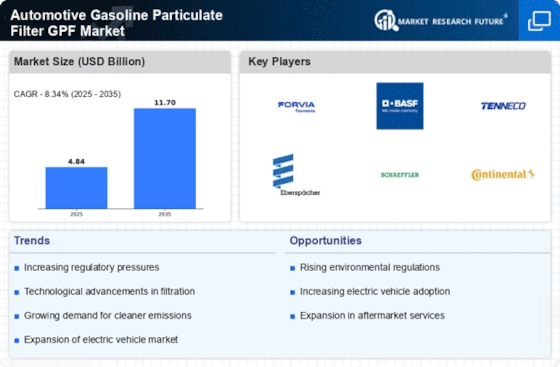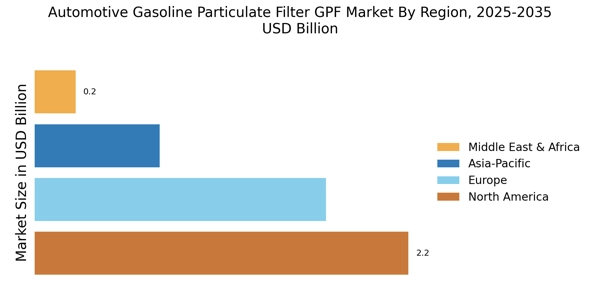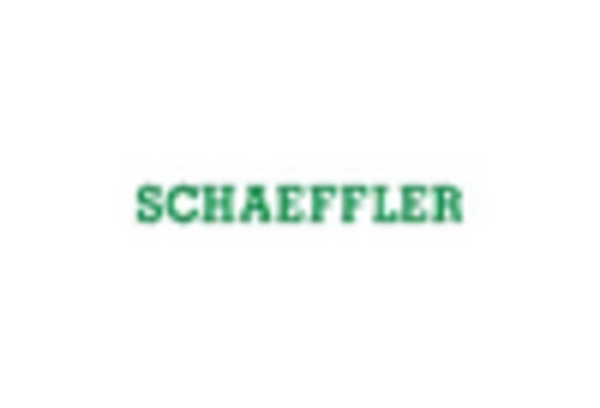Technological Innovations
Technological advancements play a pivotal role in the Automotive Gasoline Particulate Filter Market GPF Market. Innovations in materials and manufacturing processes enhance the efficiency and effectiveness of GPFs. For instance, the development of advanced ceramic substrates and improved catalyst formulations can lead to better filtration performance and durability. As automakers strive to improve fuel efficiency and reduce emissions, the integration of these technologies becomes essential. The market is likely to witness a surge in demand for high-performance GPFs, as manufacturers seek to differentiate their products in a competitive landscape. By 2025, the adoption of innovative GPF technologies is expected to contribute significantly to market growth, reflecting a shift towards more sustainable automotive solutions.
Global Supply Chain Dynamics
The Automotive Gasoline Particulate Filter Market GPF Market is also influenced by global supply chain dynamics. Fluctuations in raw material availability and pricing can impact the production costs of GPFs. For instance, the sourcing of precious metals used in catalysts can be affected by geopolitical factors and trade policies. As manufacturers navigate these challenges, they may seek alternative materials or innovative production methods to mitigate costs. This adaptability is crucial for maintaining competitiveness in the market. By 2025, the ability to manage supply chain complexities will likely play a significant role in shaping the strategies of companies within the GPF market, influencing pricing and availability of these essential components.
Regulatory Compliance Pressure
The Automotive Gasoline Particulate Filter Market GPF Market is experiencing heightened pressure due to stringent emissions regulations imposed by various governments. These regulations aim to reduce particulate matter emissions from gasoline engines, thereby promoting cleaner air quality. As a result, manufacturers are compelled to integrate GPFs into their vehicle designs to comply with these standards. The market is projected to grow as automakers invest in advanced filtration technologies to meet regulatory requirements. In 2025, it is estimated that the market for GPFs will expand significantly, driven by the need for compliance with Euro 6 and similar standards across different regions. This regulatory landscape not only influences production but also shapes consumer preferences towards cleaner vehicles.
Consumer Demand for Eco-Friendly Vehicles
The Automotive Gasoline Particulate Filter Market GPF Market is increasingly influenced by consumer demand for eco-friendly vehicles. As awareness of environmental issues rises, consumers are more inclined to choose vehicles equipped with GPFs, which help reduce harmful emissions. This shift in consumer behavior is prompting automakers to prioritize the integration of GPFs in their new models. Market data indicates that sales of vehicles with GPFs are expected to rise, reflecting a broader trend towards sustainability in the automotive sector. By 2025, it is anticipated that a significant portion of new gasoline vehicles will feature GPFs, driven by consumer preferences for cleaner and more efficient transportation options.
Automotive Industry Transition to Electrification
The transition towards electrification in the automotive sector is impacting the Automotive Gasoline Particulate Filter Market GPF Market. While electric vehicles (EVs) do not require GPFs, the ongoing hybridization of gasoline engines necessitates the continued use of GPFs in hybrid models. This dual approach allows manufacturers to cater to a broader market segment, balancing traditional gasoline engines with hybrid technologies. As automakers invest in hybrid solutions, the demand for GPFs is expected to persist, albeit with a potential shift in focus towards optimizing their performance in hybrid applications. By 2025, the market may see a diversification of GPF applications, reflecting the evolving landscape of vehicle powertrains.


















Leave a Comment